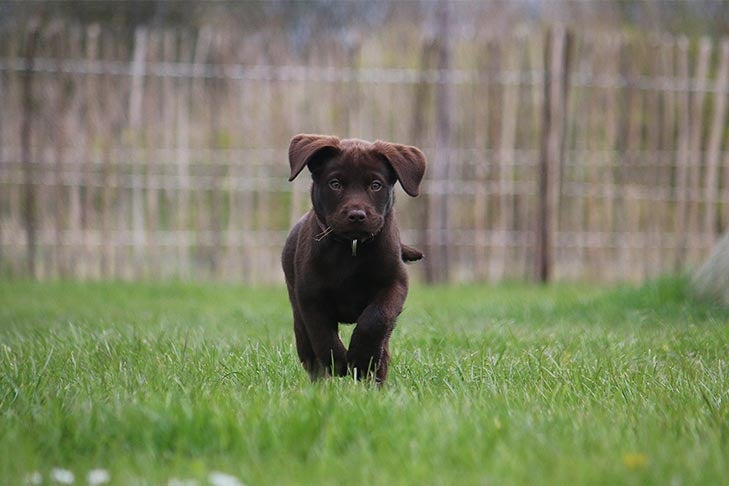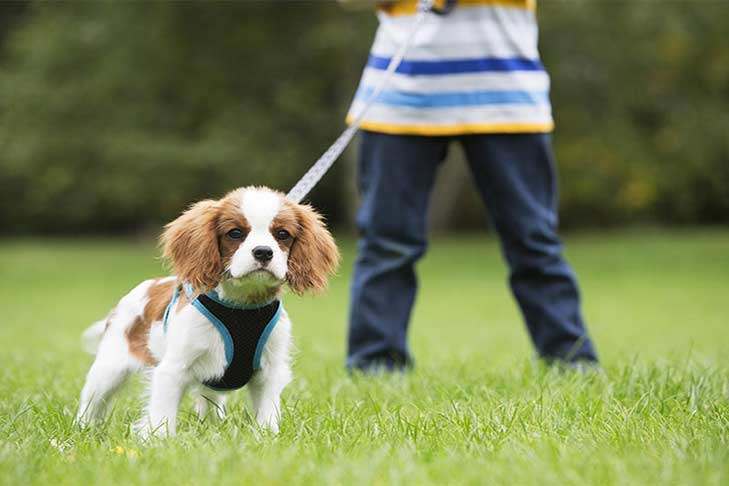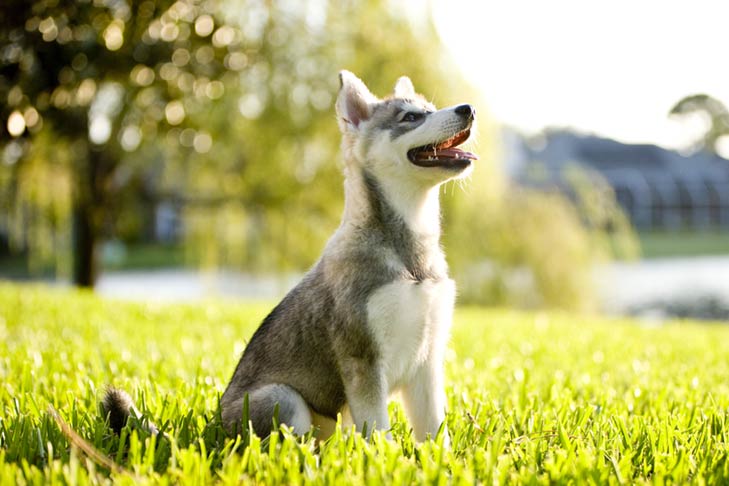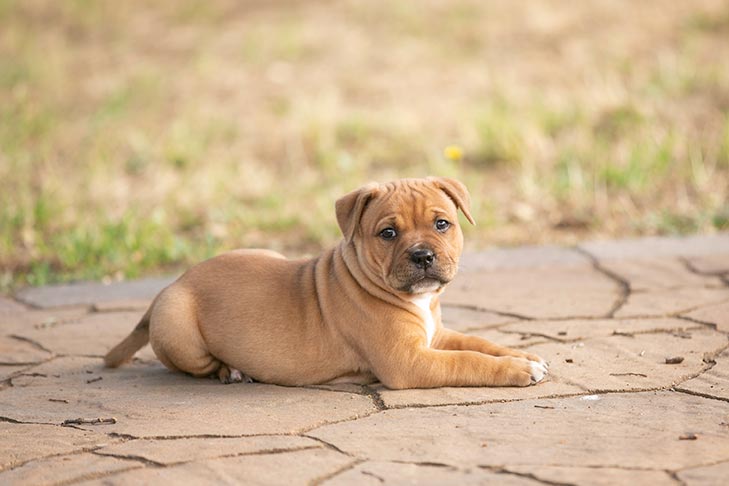To get off on the right foot (and paw!) with your pup, they'll need to know what you expect. This will give them confidence in their ability to meet the goals set for them in the future.
The basis of training should be positive reinforcement. Positive reinforcement is the process of rewarding a dog (or person!) for desired behavior, similar to receiving a paycheck for going to work. The goal is to train the behavior rather than bribe it with something your dog values.
Use of punishment, such as leash corrections or yelling, should be avoided. Punishment can make a dog confused and unsure of what is expected of them. It is critical to remember that we cannot expect dogs to know what they do not yet know, just as we would not expect a two-year-old child to know how to tie their shoes. Patience will go a long way toward teaching your new puppy proper behavior.
Reinforcement can be whatever your dog enjoys. For training treats, most people use small pieces of a "high-value" food, such as freeze-dried liver or even just their kibble. As a reward, lavish praise or the opportunity to play with a favorite toy can be used. Dogs must be taught to enjoy receiving praise. If you reward the dog with a treat while saying, "Good dog! " in a cheerful tone, they will learn that praise is good and can be used as a reward. Some dogs enjoy being petted as well. Food is frequently the most practical way to reinforce behavior.
Puppies can begin very basic training as soon as they arrive home, which is usually around 8 weeks old. Always keep training sessions brief (five to ten minutes) and on a positive note. If your puppy is having difficulty learning a new behavior, end the session by reviewing something they already know and rewarding them generously for their success. If your puppy becomes bored or frustrated, it will be counterproductive to his learning.

How to Train a Dog to Return When Called
Begin training a recall (come when called) in a quiet environment and indoors.
- Sit with your puppy and call out their name or say "come."
- Give your puppy a treat every time you say "come/name." They are not required to do anything at this time! Simply repeat the word and provide a treat. Easy!
- Next, place a treat near you on the floor. Say your puppy's name again as soon as they finish the treat on the ground. Give them another treat when they look up.
- Repeat this a few times until you can start tossing the treat further away and they can turn around to face you when you say their name. Avoid repeating your puppy's name; saying it too frequently when they don't respond encourages them to ignore it. Instead, get closer to your puppy and return to a stage where they can successfully respond to their name for the first time.
- Begin adding movement and making the game more fun once your puppy can turn around to face you! Toss a treat on the ground and walk away while calling your puppy's name. They should run after you because it's fun to chase!
- Give them lots of praise, treats, or play with a tug toy when they catch you. Coming to you should be enjoyable! Continue to expand these games over longer distances and in different locations. When training your puppy outside (always in a safe, enclosed area), keep him on a long leash at first.
Don't reach out and grab your puppy when they come to you. Some dogs may find this confusing or frightening. If your puppy is fearful, kneel and face them sideways while reaching for the collar.
Never command your dog to punish you! This will only teach them that you are unpredictable and should be avoided. Even if your dog has been up to no good, always lavishly reward them for responding to their name!
Learn more about teaching your dog to come when called.

How to Teach a Dog to Walk Off-Leash
In competition obedience training, "heel" refers to the dog walking on your left side, head even with your knee, while holding the leash loosely. Puppy training can be more relaxed, with the goal of walking politely on a loose leash without pulling. Some trainers prefer the phrases "let's go" or "forward" to "heel."
Whatever cue you choose, be consistent and use the same word every time. It is entirely up to you whether your puppy walks on your left or right side. However, be consistent about where you want them to go so they don't get confused and start zigzagging in front of you.
- To begin, ensure that your puppy is comfortable wearing a leash. At first, this may feel strange, and some puppies may bite the leash. Give your puppy treats every time you put the leash on.
- Then, with the leash in a loose loop, stand next to your puppy and give them several treats in a row for standing or sitting next to your leg.
- Take one step forward and encourage them to follow by rewarding them with another treat as they catch up.
- As you walk forward, continue to give your puppy treats at the level of your knee or hip.
- When they run in front of you, simply turn around, call them to you, and reward them in place. Then proceed. Gradually increase the distance between treats (from every step to every other step, every third step, and so on).
- When your dog is on a leash, they will eventually walk happily by your side. Allow your dog plenty of time on walks to sniff and "smell the roses." When they've had their sniffing time, say "Let's go!" in a happy voice and reward them for returning to position and walking with you.
Learn more about teaching your dog to walk on a leash.

There are two approaches to teaching your puppy the word "sit."
The first method is known as capturing.
- Hold some of your puppy's dog food or treats in front of him.
- Wait for them to take a seat. Then say "yes" and give them something to eat.
- Then, taking a step back or sideways to encourage them to stand, wait for them to sit.
- As soon as they sit, give them another treat.
- After a few repetitions, you can start saying "sit" as they sit down.
The following option is known as luring.
- Put yourself in front of your puppy and hold a treat as a lure.
- Place the treat directly in front of the pup's nose, then gradually raise the food above their head. They will most likely sit while lifting their heads to nibble on the treat.
- Allow them to eat the treat when their bottom is in contact with the ground.
- Repeat with the food lure one or two times, then remove the food and use only your empty hand, but continue to reward the puppy after they sit.
- Once they understand the hand signal for sitting, you can start saying "sit" right before you give the hand signal.
Never force your puppy into a sitting position; it can be confusing or upsetting to some dogs.
Learn more about teaching your dog to sit.

How to Train Your Dog to Lie Down
"Down" is taught in the same way that "sit" is.
- You can wait for your dog to fall asleep (beginning in a boring, small room such as a bathroom can help).
- Capture the behavior by rewarding your dog when they lie down with a treat.
- Give them the release cue to stand back up (and if necessary, encourage them with a lure), and then wait for them to lie down again.
- When they lie down quickly after standing up, you can start saying "down" right before they do.
You can also lure a down from a sit or stand position.
- Bring a treat to the dog's nose and slowly bring it to the floor.
- To begin, give the treat when the dog's elbows touch the floor.
- After a few practice sessions, start bringing your empty hand to the floor and giving the treat after they have fallen asleep.
- Begin saying "down" as you move your hand when they can reliably follow your hand signal.
Just as with sitting, never use force to get your dog to lay down.
How to Teach Your Dog to Sleep.

How to Teach Your Dog to Sit
A puppy who understands the "stay" cue will remain sitting until you tell them to get up with another cue known as the "release word." Staying put is a long-term behavior. The goal is to teach your dog to sit until the release cue is given, then gradually increase the distance.
- To begin, teach the release word. Choose a word to use, such as "OK" or "free."
- Stand in a sit or a stand with your puppy, toss a treat on the floor, and say your command as they step forward to get the treat.
- Repeat a few times until you can say the word first and then toss the treat after they start moving. This teaches the dog that the release cue indicates that you should move your feet.
- Put your dog in a sit, turn and face them, and give them a treat when they know the release cue and how to sit on cue.
- Give them another treat for staying in a sit, then let them go.
- Increase the time between treats gradually (it can help to sing the ABCs in your head and work your way up the alphabet).
- It's fine if your dog gets up before the release cue! It simply means they aren't ready to sit for that long, so you can make it easier by reducing the time.
- You can start adding distance once your dog can sit for several seconds.
- Place them in a sit and say "stay," then take one step back and return to the pup with a treat and your release word.
- Continue to build in steps, keeping it simple enough for your dog to succeed. Experiment with both facing them and walking away with your back to them (which is more realistic).
Once your dog is able to stay, gradually increase the distance. This also applies to the "sit." The more thoroughly they learn it, the longer they can sit. The key is not to set unrealistic expectations. Because training goals are attained in increments, you may need to slow down and concentrate on one thing at a time. Sessions should be brief and effective in order for the training to "stick."
Learn more about teaching your dog to stay.
Puppy Training Basics
Keep training sessions brief and enjoyable. Finish each session on a high note. If you believe your dog is having difficulty learning or is "stubborn," consider slowing down your training and increasing the value of your rewards. Do you need to slow down and make the steps easier, or does your dog require a larger reward for a more difficult exercise?
The "Basic 5" cues will provide a solid foundation for your puppy's future training. And just think, if you and your puppy keep working hard—and having fun—at training, you might one day be Obedience champions!

0 Comments